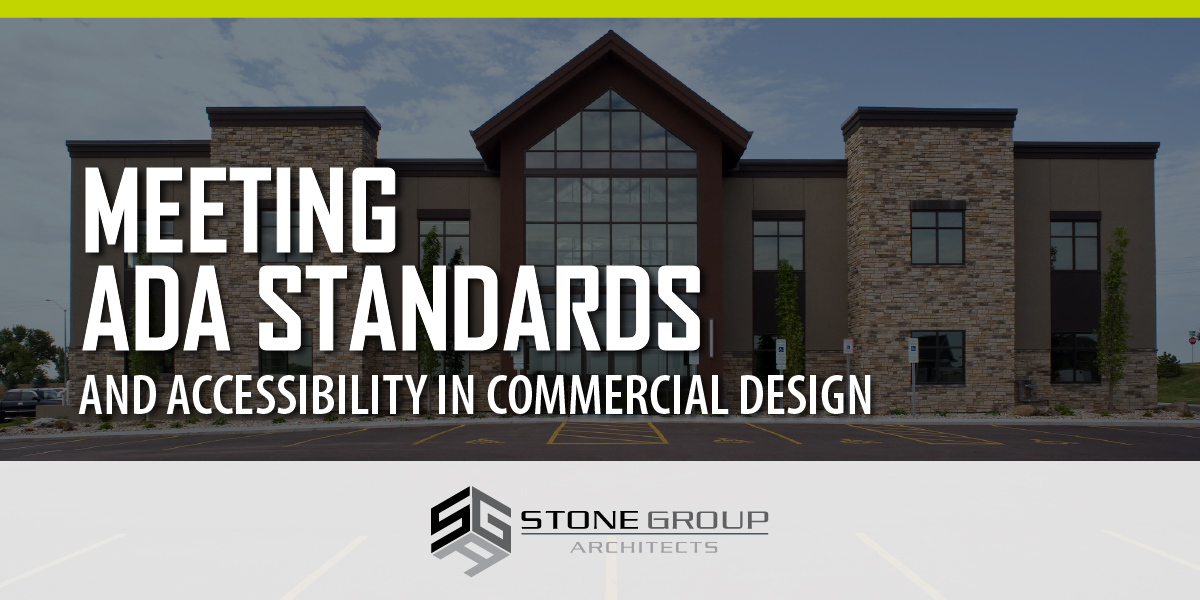At Stone Group Architects, accessibility in commercial design isn’t just about meeting code; it’s about creating spaces that are functional, safe, and welcoming for everyone. While ADA (Americans with Disabilities Act) guidelines establish critical requirements, our approach goes further, focusing on how every person experiences a space.
Whether you’re planning a commercial development, a municipal building, or a healthcare facility, accessibility should be a foundational design principle, not an afterthought.
Accessibility Starts Early in the Design Process
Too often, ADA compliance in commercial design is treated as a box to check near the end of a project. When that happens, design adjustments become more expensive and less effective. By starting these conversations early in the design phase, architects can ensure accessibility influences the overall layout and flow of the building from the start.
Designing with accessibility in mind from the beginning allows teams to:
- Plan for ample clearances and turning radius before walls are placed.
- Anticipate elevation changes and allow space for ramps or lifts.
- Create logical traffic flow that accommodates all users, not just those without physical limitations.
- Maintain design flexibility, allowing spaces to adapt as needs change.
It’s far easier to reduce room sizes later than to convince owners mid-project that a space must be expanded to meet accessibility needs, especially when that expansion impacts the budget.
As Architectural Associate Kyle Kueper puts it:
“After working in the design/construction industry, I have quickly realized that accessibility requirements in commercial design are, in many ways, viewed as just another hurdle that needs to be cleared in order to complete a project. I feel this defeats the ultimate purpose behind accessibility requirements and is a reversed approach to accessible design. As a designer, I believe accessibility related conversations should be had early in the design process and significantly influence program and flow when developing schematic floor plans.”
Designing Commercial Spaces with Purpose and Practicality
When considering accessibility, small design decisions make a big impact. For example:
- Entrances: Provide enough room for doors to open fully while allowing space for someone using a wheelchair to maneuver. Evaluate the placement of automatic door buttons so they aren’t obstructed by door swings.
- Restrooms: Avoid squeezing in fixtures to save space. Instead, design for comfort and dignity for all users. Where possible, consider doorless entries to eliminate clearance, reach, and hardware concerns altogether.
- Common Areas: Ask whether every user can easily reach and enjoy the space. Are ramps needed? Are sightlines, lighting, and circulation patterns inviting?
For examples of well-designed accessible spaces, explore projects like VA Columbia Stepdown Unit or the SDSU Wellness Center.
The Role of Wayfinding in Accessibility
Wayfinding is a key consideration during the design phase and plays a major role in how users experience a space. In healthcare and large-scale facilities, clear and intuitive navigation can significantly impact accessibility, safety, and comfort.
Thoughtful wayfinding design includes:
- Logical circulation patterns help users easily orient themselves.
- Consistent visual cues like color, texture, and lighting to guide movement.
- Accessible signage with high contrast, tactile text, and appropriate mounting heights.
When done well, wayfinding allows all users, regardless of ability or familiarity with the space, to navigate confidently and independently.
How Interior Design Influences Accessibility
Interior design is a powerful tool for improving accessibility and inclusivity. Our in-house Interior Design team integrates accessibility considerations into every finish selection, layout decision, and furniture plan to ensure that spaces are both beautiful and functional.
As our Interior Design Director, Haley Kaspari, explains that accessible design extends beyond meeting ADA measurements; it’s about creating environments that feel intuitive, comfortable, and inclusive. For example:
- Choosing contrasting materials and colors helps users with low vision differentiate surfaces and pathways.
- Selecting appropriate lighting and acoustics improves spatial awareness and reduces sensory strain.
- Incorporating adaptable furniture layouts ensures flexibility for people using mobility devices.
Having an in-house interior design team allows for seamless collaboration with our architects, ensuring accessibility is considered holistically from concept to completion, a key advantage over firms that outsource design work.
Technology and Flexibility in Modern Accessibility
Innovations in commercial building design, like smart lighting, sensor-based entry systems, and adaptable controls, enhance independence and ease of use. But simplicity matters too; a wall-mounted button may still be the most reliable choice.
Another key consideration is spatial flexibility. In multipurpose areas like conference rooms, ensure furniture arrangements allow everyone to participate comfortably: Can a wheelchair user sit at any table without special adjustments? Is there room for a service dog to rest beside its handler without crowding others?
Designing adaptable, inclusive spaces helps everyone feel part of the same environment.
Rethinking Vertical Access
When a facility includes multiple levels, accessibility shouldn’t rely solely on ramps. While ramps are sometimes the most cost-effective solution, they can pose challenges for users in non-motorized wheelchairs, especially on long inclines. Whenever feasible, consider elevators or lifts, they may require more investment upfront but provide a safer, more user-friendly experience for all visitors.
ADA Compliance Is More Than Wheelchair Access
True inclusive commercial design goes beyond just wheelchair accommodations. It considers:
- Visual impairments: High-contrast signage and tactile elements
- Emergency situations: Areas of refuge for safe evacuation
- Mobility support: Handrails, wider paths, and seating options
- Reach range: Switches, counters, and features that everyone can access
Designing for Everyone, Not Just Code
At Stone Group Architects, accessibility is central to our people-first and user-centered approach. We believe great commercial design is inclusive design. As architects, we view it as our social responsibility to create spaces that meet and exceed ADA standards, ensuring every person, regardless of ability, can independently experience and enjoy the environments we design.
True design excellence means designing for everyone. From government buildings to modern office remodels, our team strives to ensure that every user feels welcome, safe, and empowered. Contact us today to discuss how thoughtful, inclusive design can make your next project more accessible for all.

